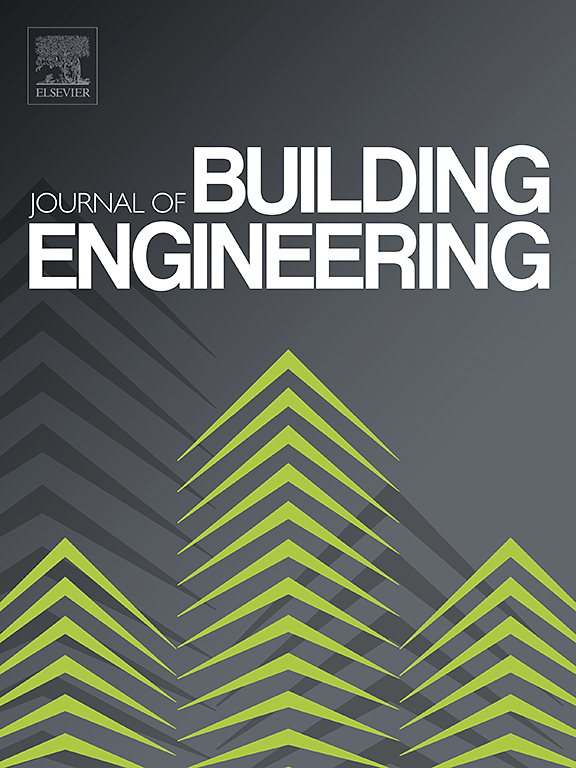玄武岩纤维增强活性粉末混凝土的 I 型动态断裂演化和能量耗散
IF 6.7
2区 工程技术
Q1 CONSTRUCTION & BUILDING TECHNOLOGY
引用次数: 0
摘要
采用缺口半圆形弯曲(NSCB)试件对玄武岩纤维增强活性粉末混凝土(BFRRPC)进行了动态断裂实验,旨在研究其模态-I动态断裂特征。本研究基于分裂霍普金森压力棒(SHPB)和数字图像相关(DIC)系统,重点研究了不同玄武岩纤维含量的 BFRRPC 的动态断裂韧性、断裂过程区(FPZ)、裂纹扩展、断裂路径的分形维度和能量演化。结果表明,在微观实验结果中,基体中存在玄武岩纤维断裂、拔出和界面断裂,这是纤维存在导致 RPC 断裂韧性增强的内在原因。BFRRPC 的断裂韧性提高了 24.7% 到 42.7%,当加入 1.0% 的玄武岩纤维时,断裂韧性明显提高。通过位移-应变混合校准方法,可以有效定位 BFRRPC 的裂缝和 FPZ 尖端。添加 1.0 % 的玄武岩纤维可有效延迟试样的裂纹萌发,随着加载水平的增加,裂纹萌发的时间会提前。CTOD 和 FPZ 尖端张开位移与加载水平无关。玄武岩纤维可使 BFRRPC 的分形尺寸相对较低且稳定,从而有效降低开裂度并增加裂纹的粗糙度。玄武岩纤维可有效提高 RPC 的断裂能。耗散能主要由 BFRRPC 断裂所消耗的能量(断裂能)构成,总体残余动能比(残余动能与耗散能之比)一般低于 1.90%。本文章由计算机程序翻译,如有差异,请以英文原文为准。
Mode-I dynamic fracture evolution and energy dissipation of basalt fiber reinforced reactive powder concrete
Dynamic fracture experiments on basalt fiber reinforced reactive powder concrete (BFRRPC) were conducted using notched semi-circular bending (NSCB) specimens, aiming to investigate the Mode-I dynamic fracture characteristics. Based on the split Hopkinson pressure bar (SHPB) and digital image correlation (DIC) systems, this study focused on investigating the dynamic fracture toughness, fracture process zone (FPZ), crack propagation, fractal dimension of fracture path, and energy evolution of BFRRPC with different basalt fiber contents. The results show the basalt fiber break, pull-out and interface fracture in the matrix in the microscopic experiment results, which are the intrinsic reasons for the enhancement of fracture toughness in RPC due to the fiber presence. The increases in fracture toughness of BFRRPC range between 24.7 % and 42.7 %, with a notable enhancement observed when incorporating 1.0 % basalt fiber content. The crack and the FPZ tip of BFRRPC can be located effectively by the method of displacement-strain mixed calibration. The addition of 1.0 % basalt fiber content effectively delays the crack initiation in specimens, with crack initiation occurring earlier as the loading level increases. The CTOD and FPZ tip opening displacement have nothing to do with the loading level. Basalt fibers can lead to relatively lower and stable fractal dimensions of BFRRPC, effectively reducing the cracking degree and increasing the roughness of cracks. Basalt fiber effectively enhances the fracture energy of RPC. The dissipated energy is mainly composed of the energy consumed by the fracture (fracture energy) of BFRRPC, with the overall residual kinetic energy ratio (the ratio of residual kinetic energy to dissipated energy) generally below 1.90 %.
求助全文
通过发布文献求助,成功后即可免费获取论文全文。
去求助
来源期刊

Journal of building engineering
Engineering-Civil and Structural Engineering
CiteScore
10.00
自引率
12.50%
发文量
1901
审稿时长
35 days
期刊介绍:
The Journal of Building Engineering is an interdisciplinary journal that covers all aspects of science and technology concerned with the whole life cycle of the built environment; from the design phase through to construction, operation, performance, maintenance and its deterioration.
 求助内容:
求助内容: 应助结果提醒方式:
应助结果提醒方式:


